Rheological Investigation of Welding Waste-Derived Graphene Oxide in Water-Based Drilling Fluids
Abstract
:1. Introduction
2. Materials and Methods
2.1. Chemicals and Reagents
2.2. Synthesis of Welding Waste-Derived GO
2.3. Characterization of GO
2.4. Drilling Fluid Preparation
2.5. Evaluation of Rheological and Filtration Properties
3. Results and Discussion
3.1. Characterization of GO
3.2. Properties of Drilling Fluids
3.2.1. Plastic Viscosity
3.2.2. Yield Point
3.2.3. Gel Strength
3.2.4. Filtrate Loss
3.2.5. Mud Cake Thickness
4. Conclusions
- The effect of the lowest concentration of welding waste-derived GO showed the lowest FL up to 55.6%.
- The remarkable reduction of MCT was obtained by adding highest concentration of raw welding waste (39.7%). However, the highest concentration of welding waste-derived GO and commercial GO showed reductions of 20.9% and 59.9%, respectively.
- The lowest concentration of commercial GO showed an MCT reduction of 46.1% compared with welding waste-derived GO, which showed a reduction of up to 32.6%. The results verify that the use of novel nanocomposites in drilling fluids is capable of increasing efficiency, while reducing operating cost. These waste-derived economical additives can be excellent alternatives to commercial GO.
- The linked structure of GO allows more water to be trapped between layers. This causes an increase in viscosity and yield stress, while reducing fluid filtration.
- The addition of waste-derived GO could be a useful substitute of commercial GO.
- The major cost to produce GO is the cost of chemicals, equipment and labor. The chemicals required include H2SO4, KMnO4, NaNO3 and H2O2, which are all abundantly available in the open market at very low prices. Moreover, these are commonly used chemicals and are available in almost every lab. The cost of these consumables is same as for commercial GO and GO derived from welding wastes. These only differ in the supply of raw materials. For commercial GO, the raw material is pure graphite, which must be imported at high cost, whereas for synthesis of GO from welding waste, the raw material is a waste product and available free of cost. Thus, the total production cost of welding waste-derived GO is much lower than that of t commercial GO.
- This research focused on the conversion of hazardous waste into GO which validates the conversion of many other waste materials into graphene derivatives and potential filtrate loss agents. Thus, this study paves the way for utilizing a variety of waste sources in sustainable and cost-effective drilling operations. The availability of carbonaceous industrial waste, therefore, can stimulate initiatives to convert such industrial waste into value-added products.
5. Future Perspectives
Author Contributions
Funding
Institutional Review Board Statement
Informed Consent Statement
Data Availability Statement
Conflicts of Interest
Abbreviations
| API | American Petroleum Institute |
| AV | Apparent viscosity |
| EDX | Energy Dispersive X-ray analysis |
| PV | Plastic viscosity |
| YP | Yield point |
| GS | Gel strength |
| FL | Filtrate loss |
| FTIR | Fourier Transform Infrared Spectroscopy |
| FESEM | Field Emission Scanning Electron Microscopy |
| MCT | Mud cake thickness |
| GO | Graphene oxide |
| WBDF | Water-based drilling fluids |
| XRD | X-ray Diffraction Crystallography |
References
- Saini, S.; Singh, K. Utilisation of steel slag as welding flux and its chemical and thermal characterisation. Mater. Sci. Technol. 2022, 1–12. [Google Scholar] [CrossRef]
- Garg, J.; Singh, K. Slag recycling in submerged arc welding and its effects on the quality of stainless steel claddings. Mater. Des. 2016, 108, 689–698. [Google Scholar] [CrossRef]
- Kaptanoglu, M.; Eroglu, M. Reusability of metallurgical slag waste in submerged arc welding powder for hardfacing. Mater. Test. 2020, 62, 177–183. [Google Scholar] [CrossRef]
- Saleem, H.; Zaidi, S.J.; Alnuaimi, N.A. Recent Advancements in the Nanomaterial Application in Concrete and Its Ecological Impact. Materials 2021, 14, 6387. [Google Scholar] [CrossRef]
- Kaya, M. Recovery of metals and nonmetals from electronic waste by physical and chemical recycling processes. Waste Manag. 2016, 57, 64–90. [Google Scholar] [CrossRef]
- Ramesh, S.T.; Gandhimathi, R.; Nidheesh, P.V.; Rajakumar, S.; Prateepkumar, S. Use of furnace slag and welding slag as replacement for sand in concrete. Int. J. Energy Environ. Eng. 2013, 4, 1–6. [Google Scholar] [CrossRef] [Green Version]
- Loaiza, A.; Colorado, H.A. Marshall stability and flow tests for asphalt concrete containing electric arc furnace dust waste with high ZnO contents from the steel making process. Constr. Build. Mater. 2018, 166, 769–778. [Google Scholar] [CrossRef]
- Laska, A.; Szkodo, M. Manufacturing parameters, materials, and welds properties of butt friction stir welded joints–overview. Materials 2020, 13, 4940. [Google Scholar] [CrossRef]
- Magzoub, M.I.; Ibrahim, M.H.; Nasser, M.S.; El-Naas, M.H.; Amani, M. Utilization of Steel-Making Dust in Drilling Fluids Formulations. Processes 2020, 8, 538. [Google Scholar] [CrossRef]
- Bayat, A.E.; Moghanloo, P.J.; Piroozian, A.; Rafati, R. Experimental investigation of rheological and filtration properties of water-based drilling fluids in presence of various nanoparticles. Colloids Surf. A Physicochem. Eng. Asp. 2018, 555, 256–263. [Google Scholar] [CrossRef]
- Misbah, B.; Sedaghat, A.; Rashidi, M.; Sabati, M.; Vaidyan, K.; Ali, N.; Omar, M.A.A.; Dehshiri, S.S.H. Friction reduction of Al2O3, SiO2, and TiO2 nanoparticles added to non-Newtonian water based mud in a rotating medium. J. Pet. Sci. Eng. 2022, 217, 110927. [Google Scholar] [CrossRef]
- Lin, L.; Feng, K.; Wang, P.; Wan, Z.; Kong, X.; Li, J. Hazardous waste from the global shipbreaking industry: Historical inventory and future pathways. Glob. Environ. Change 2022, 76, 102581. [Google Scholar] [CrossRef]
- Binnemans, K.; Jones, P.T.; Blanpain, B.; Van Gerven, T.; Pontikes, Y. Towards zero-waste valorisation of rare-earth-containing industrial process residues: A critical review. J. Clean. Prod. 2015, 99, 17–38. [Google Scholar] [CrossRef] [Green Version]
- Mokshein, S.E. Welding Waste In Vocational College: Should It Be Properly Managed? J. Teknol. 2015, 72. [Google Scholar] [CrossRef] [Green Version]
- Rizkya, I.; Syahputri, K.; Sari, R.M.; Siregar, I. 5S implementation in welding workshop—A lean tool in waste minimization. In IOP Conference Series: Materials Science and Engineering; IOP Publishing: Bristol, UK, 2019; Volume 505, p. 012018. [Google Scholar]
- Ikram, R.; Jan, B.M.; Ahmad, W. An overview of industrial scalable production of graphene oxide and analytical approaches for synthesis and characterization. J. Mater. Res. Technol. 2020, 9, 11587–11610. [Google Scholar] [CrossRef]
- Ikram, R.; Mohamed Jan, B.; Vejpravova, J.; Choudhary, M.I.; Zaman Chowdhury, Z. Recent advances of graphene-derived nanocomposites in water-based drilling fluids. Nanomaterials 2020, 10, 2004. [Google Scholar] [CrossRef]
- Villada, Y.; Busatto, C.; Casis, N.; Estenoz, D. Use of synthetic calcium carbonate particles as an additive in water-based drilling fluids. Colloids Surf. A Physicochem. Eng. Asp. 2022, 652, 129801. [Google Scholar] [CrossRef]
- Kusrini, E.; Oktavianto, F.; Usman, A.; Mawarni, D.P.; Alhamid, M.I. Synthesis, characterization, and performance of graphene oxide and phosphorylated graphene oxide as additive in water-based drilling fluids. Appl. Surf. Sci. 2020, 506, 145005. [Google Scholar] [CrossRef]
- Ikram, R.; Mohamed Jan, B.; Sidek, A.; Kenanakis, G. Utilization of eco-friendly waste generated nanomaterials in water-based drilling fluids; state of the art review. Materials 2021, 14, 4171. [Google Scholar] [CrossRef]
- Ma, J.; Pang, S.; Zhang, Z.; Xia, B.; An, Y. Experimental study on the polymer/graphene oxide composite as a fluid loss agent for water-based drilling fluids. ACS Omega 2021, 6, 9750–9763. [Google Scholar] [CrossRef]
- Ikram, R.; Jan, B.M.; Vejpravova, J. Towards recent tendencies in drilling fluids: Application of carbon-based nanomaterials. J. Mater. Res. Technol. 2021, 15, 3733–3758. [Google Scholar] [CrossRef]
- Rafati, R.; Smith, S.R.; Haddad, A.S.; Novara, R.; Hamidi, H. Effect of nanoparticles on the modifications of drilling fluids properties: A review of recent advances. J. Pet. Sci. Eng. 2018, 161, 61–76. [Google Scholar] [CrossRef] [Green Version]
- Zhao, X.; Qiu, Z.; Sun, B.; Liu, S.; Xing, X.; Wang, M. Formation damage mechanisms associated with drilling and completion fluids for deepwater reservoirs. J. Pet. Sci. Eng. 2019, 173, 112–121. [Google Scholar] [CrossRef]
- Vryzas, Z.; Kelessidis, V.C. Nano-based drilling fluids: A review. Energies 2017, 10, 540. [Google Scholar] [CrossRef]
- Martín-Alfonso, M.J.; Pozo, J.; Delgado-Sánchez, C.; Martínez-Boza, F.J. Thermal and Rheological Properties of Hydrophobic Nanosilica in Sunflower Oil Suspensions at High Pressures. Nanomaterials 2021, 11, 3037. [Google Scholar] [CrossRef]
- Wang, Q.; Slaný, M.; Gu, X.; Miao, Z.; Du, W.; Zhang, J.; Gang, C. Lubricity and rheological properties of highly dispersed graphite in clay-water-based drilling fluids. Materials 2022, 15, 1083. [Google Scholar] [CrossRef]
- Zinchik, S.; Klinger, J.L.; Westover, T.L.; Donepudi, Y.; Hernandez, S.; Naber, J.D.; Bar-Ziv, E. Evaluation of fast pyrolysis feedstock conversion with a mixing paddle reactor. Fuel Process. Technol. 2018, 171, 124–132. [Google Scholar] [CrossRef]
- Ikram, R.; Jan, B.M.; Ahmad, W. Advances in synthesis of graphene derivatives using industrial wastes precursors; prospects and challenges. J. Mater. Res. Technol. 2020, 9, 15924–15951. [Google Scholar] [CrossRef]
- Chen, J.; Yao, B.; Li, C.; Shi, G. An improved Hummers method for eco-friendly synthesis of graphene oxide. Carbon 2013, 64, 225–229. [Google Scholar] [CrossRef]
- Yu, H.; Zhang, B.; Bulin, C.; Li, R.; Xing, R. High-efficient synthesis of graphene oxide based on improved hummers method. Sci. Rep. 2016, 6, 1–7. [Google Scholar] [CrossRef]
- Boudouh, D.; Ikram, R.; Mohamed Jan, B.; Simon Cornelis Metselaar, H.; Hamana, D.; Kenanakis, G. Synthesis, Characterization and Filtration Properties of Ecofriendly Fe3O4 Nanoparticles Derived from Olive Leaves Extract. Materials 2021, 14, 4306. [Google Scholar] [CrossRef] [PubMed]
- Yang, J.; Sun, J.; Wang, R.; Liu, F.; Wang, J.; Qu, Y.; Wang, P.; Huang, H.; Liu, L.; Zhao, Z. Laponite-polymer composite as a rheology modifier and filtration loss reducer for water-based drilling fluids at high temperature. Colloids Surf. A Physicochem. Eng. Asp. 2022, 655, 130261. [Google Scholar] [CrossRef]
- Cortea, I.M.; Ghervase, L.; Rădvan, R.; Serițan, G. Assessment of Easily Accessible Spectroscopic Techniques Coupled with Multivariate Analysis for the Qualitative Characterization and Differentiation of Earth Pigments of Various Provenance. Minerals 2022, 12, 755. [Google Scholar] [CrossRef]
- Luo, X.; Wang, C.; Luo, S.; Dong, R.; Tu, X.; Zeng, G. Adsorption of As (III) and As (V) from water using magnetite Fe3O4-reduced graphite oxide–MnO2 nanocomposites. Chem. Eng. J. 2012, 187, 45–52. [Google Scholar] [CrossRef]
- Chandra, V.; Park, J.; Chun, Y.; Lee, J.W.; Hwang, I.C.; Kim, K.S. Water-dispersible magnetite-reduced graphene oxide composites for arsenic removal. ACS Nano 2010, 4, 3979–3986. [Google Scholar] [CrossRef]
- Chumming, J.; Xiangqin, L. Electrochemical synthesis of Fe3O4-PB nanoparticles with core-shell structure and its electrocatalytic reduction toward H2O2. J. Solid State Electrochem. 2009, 13, 1273–1278. [Google Scholar] [CrossRef]
- Mbah, C.N.; Ugwuanyi, B.C.; Nnakwo, K.C. Effect of welding parameters on the mechanical properties of arc–welded C1035 medium carbon steel. Int. J. Res. Adv. Eng. Technol. 2019, 5, 30–33. [Google Scholar]
- Francis, A.A.; Abdel Rahman, M.K. Transforming submerged-arc welding slags into magnetic glass-ceramics. Int. J. Sustain. Eng. 2016, 9, 411–418. [Google Scholar] [CrossRef]
- Ananthi, A.; Karthikeyan, J. Properties of industrial slag as fine aggregate in concrete. Int. J. Eng. Technol. Innov. 2015, 5, 132. [Google Scholar]
- Chu, Q.; Lin, L. Synthesis and properties of an improved agent with restricted viscosity and shearing strength in water-based drilling fluid. J. Pet. Sci. Eng. 2019, 173, 1254–1263. [Google Scholar] [CrossRef]
- Moraveji, M.K.; Ghaffarkhah, A.; Agin, F.; Talebkeikhah, M.; Jahanshahi, A.; Kalantar, A.; Amirhosseini, S.F.; Karimifard, M.; Mortazavipour, S.I.; Sehat, A.A.; et al. Application of amorphous silica nanoparticles in improving the rheological properties, filtration and shale stability of glycol-based drilling fluids. Int. Commun. Heat Mass Transf. 2020, 115, 104625. [Google Scholar] [CrossRef]
- Saboori, R.; Sabbaghi, S.; Kalantariasl, A. Improvement of rheological, filtration and thermal conductivity of bentonite drilling fluid using copper oxide/polyacrylamide nanocomposite. Powder Technol. 2019, 353, 257–266. [Google Scholar] [CrossRef]
- Huang, W.A.; Wang, J.W.; Lei, M.; Li, G.R.; Duan, Z.F.; Li, Z.J.; Yu, S.F. Investigation of regulating rheological properties of water-based drilling fluids by ultrasound. Pet. Sci. 2021, 18, 1698–1708. [Google Scholar] [CrossRef]
- Kosynkin, D.V.; Ceriotti, G.; Wilson, K.C.; Lomeda, J.R.; Scorsone, J.T.; Patel, A.D.; Friedheim, J.E.; Tour, J.M. Graphene oxide as a high-performance fluid-loss-control additive in water-based drilling fluids. ACS Appl. Mater. Interfaces 2012, 4, 222–227. [Google Scholar] [CrossRef] [PubMed]
- Kumar, B.D. and Kulkarni, S.D. A review of synthetic polymers as filtration control additives for water-based drilling fluids for high-temperature applications. J. Pet. Sci. Eng. 2022, 215, 110712. [Google Scholar]
- Zhong, H.; Guan, Y.; Su, J.; Zhang, X.; Lu, M.; Qiu, Z.; Huang, W. Hydrothermal synthesis of bentonite carbon composites for ultra-high temperature filtration control in water-based drilling fluid. Appl. Clay Sci. 2022, 230, 106699. [Google Scholar] [CrossRef]
- Li, J.; Sun, J.; Lv, K.; Ji, Y.; Liu, J.; Huang, X.; Bai, Y.; Wang, J.; Jin, J.; Shi, S. Temperature-and Salt-Resistant Micro-Crosslinked Polyampholyte Gel as Fluid-Loss Additive for Water-Based Drilling Fluids. Gels 2022, 8, 289. [Google Scholar] [CrossRef] [PubMed]
- Gamal, H.; Elkatatny, S.; Basfar, S.; Al-Majed, A. Effect of pH on rheological and filtration properties of water-based drilling fluid based on bentonite. Sustainability 2019, 11, 6714. [Google Scholar] [CrossRef] [Green Version]
- Medved, I.; Gaurina-Međimurec, N.; Novak Mavar, K.; Mijić, P. Waste mandarin peel as an eco-friendly water-based drilling fluid additive. Energies 2022, 15, 2591. [Google Scholar] [CrossRef]

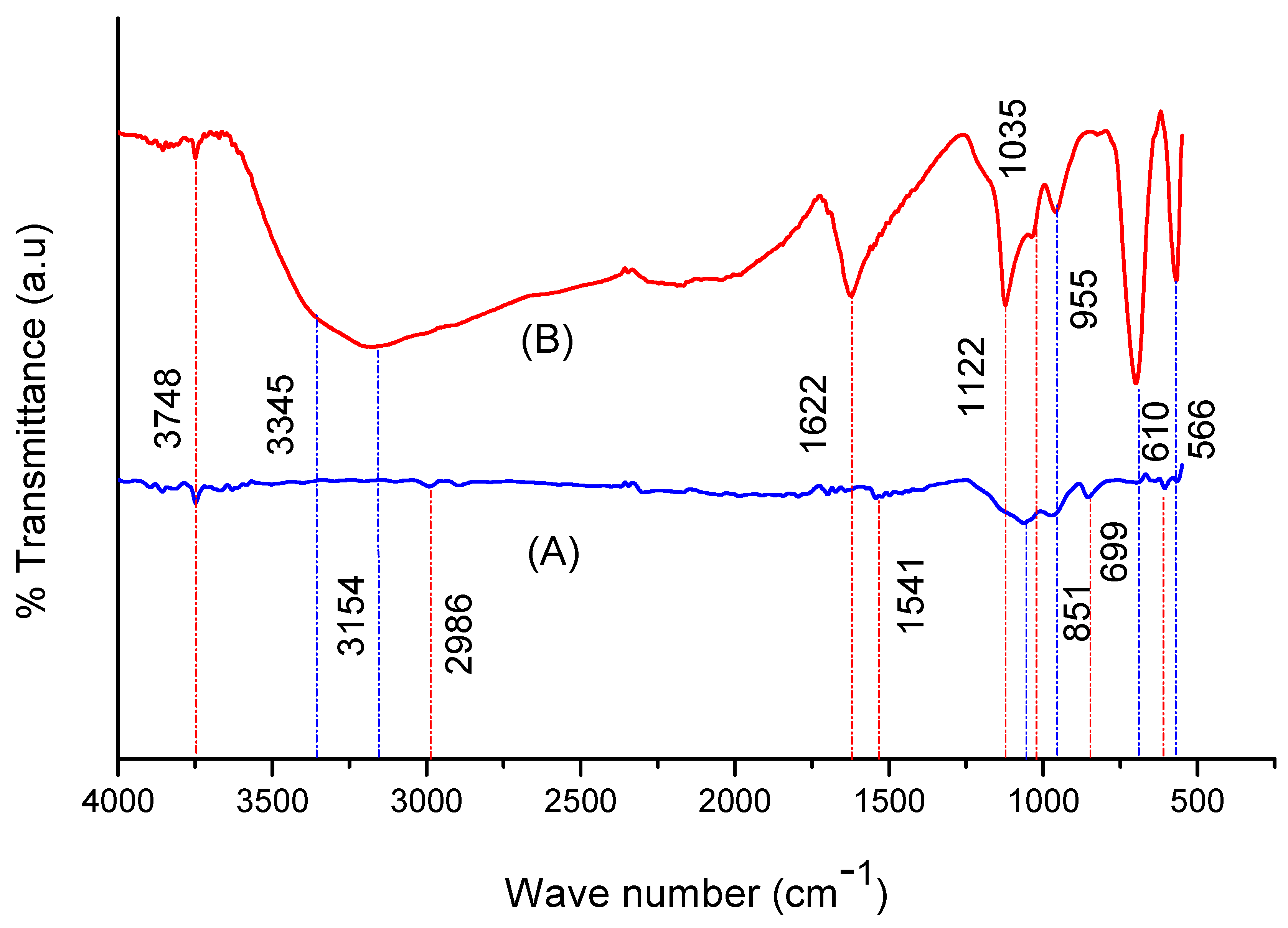
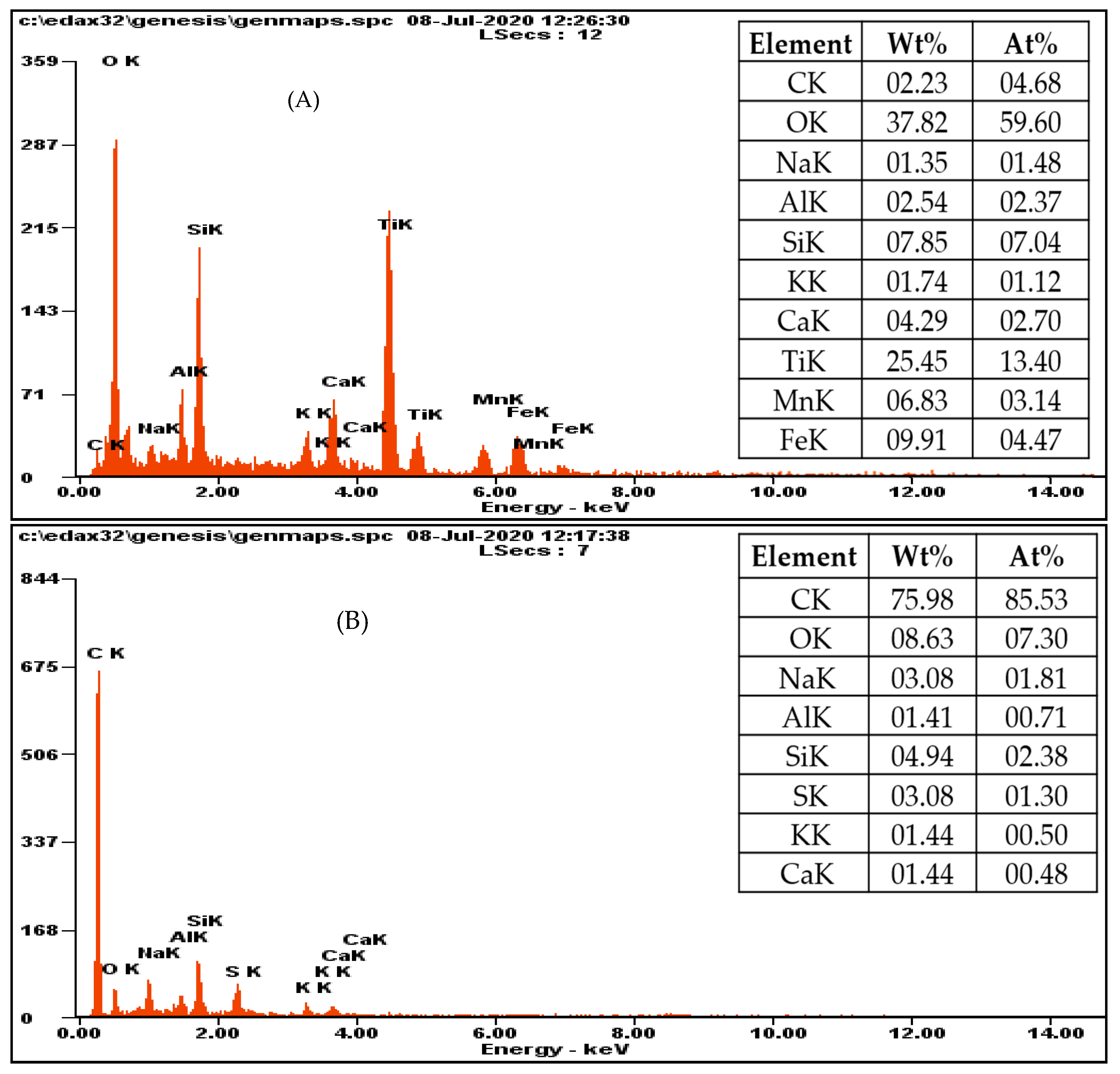
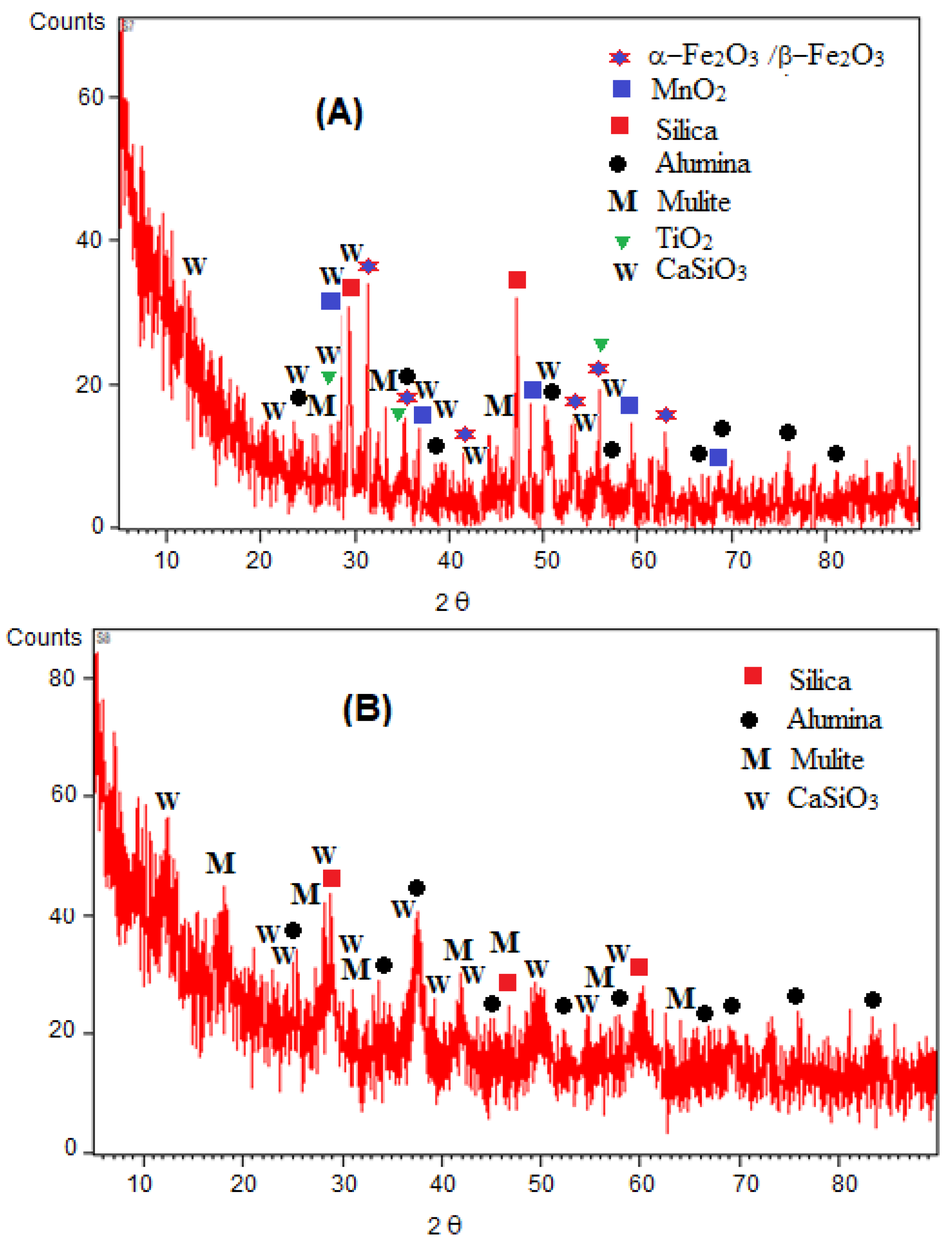
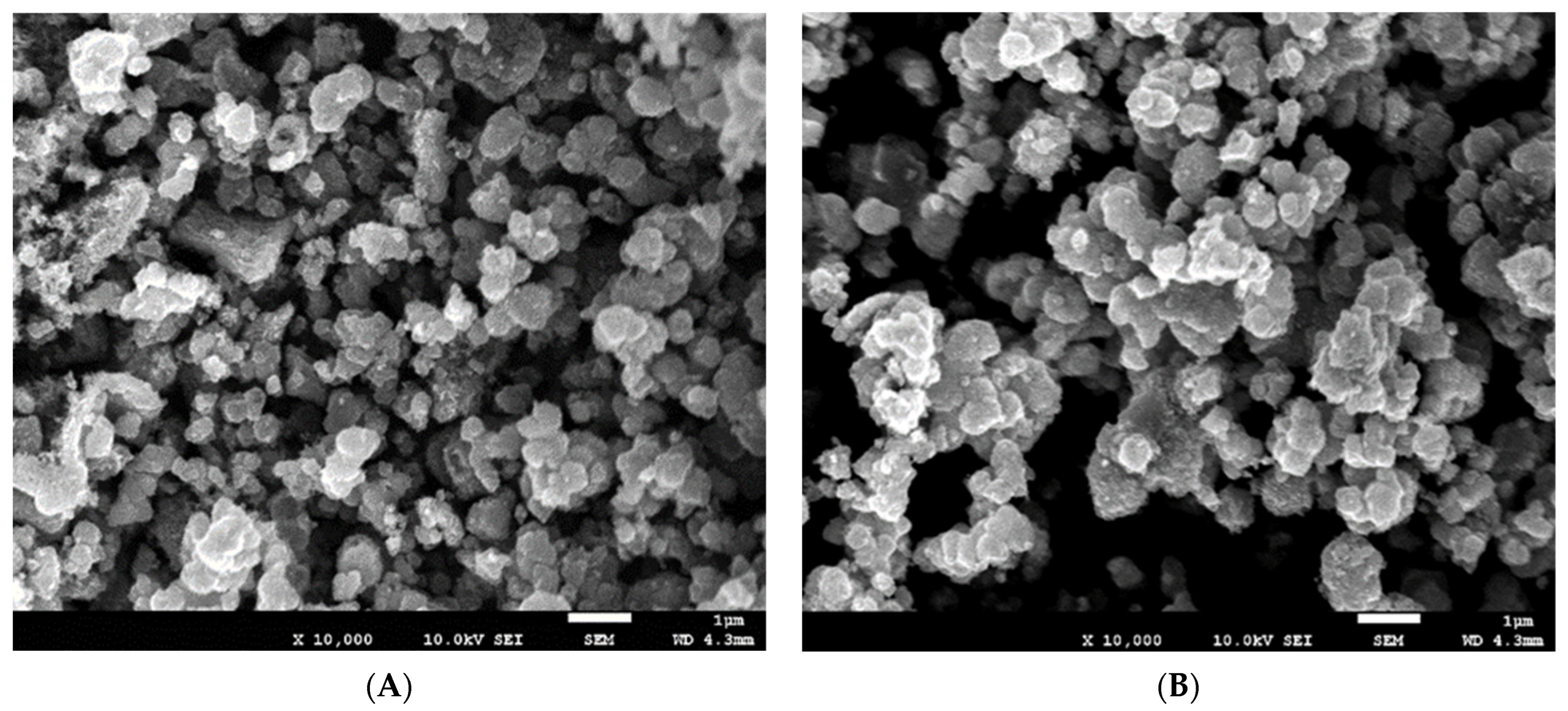
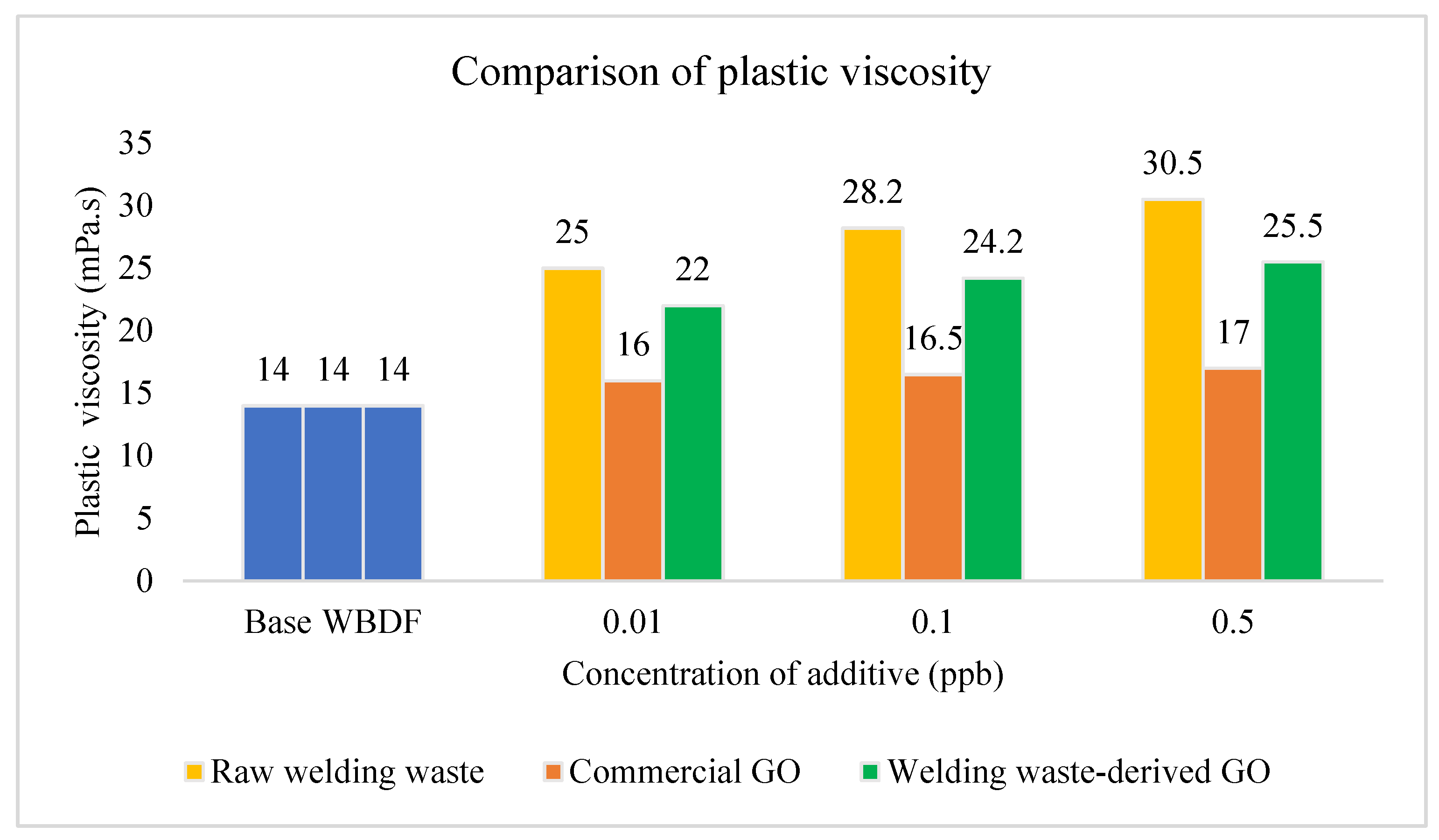

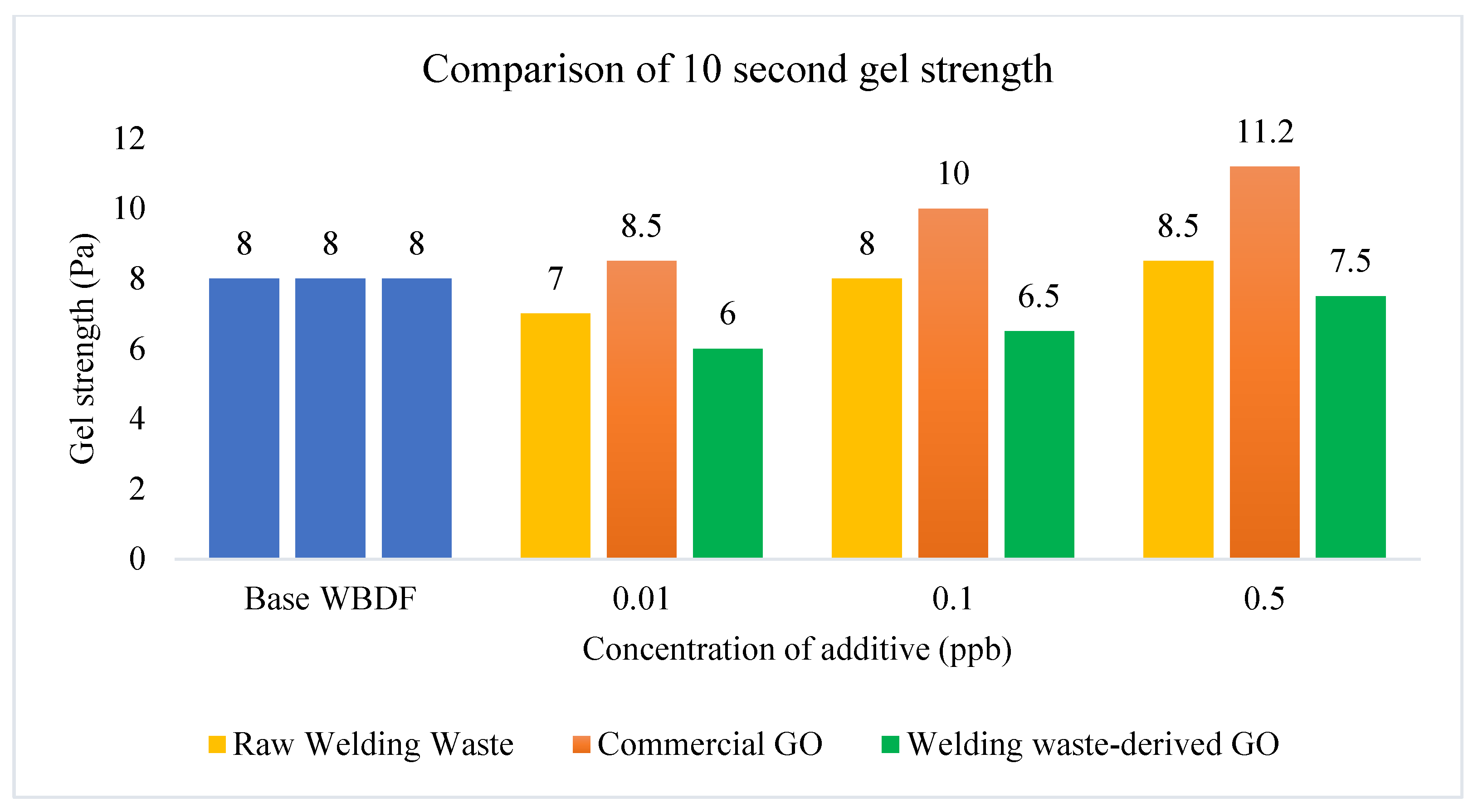

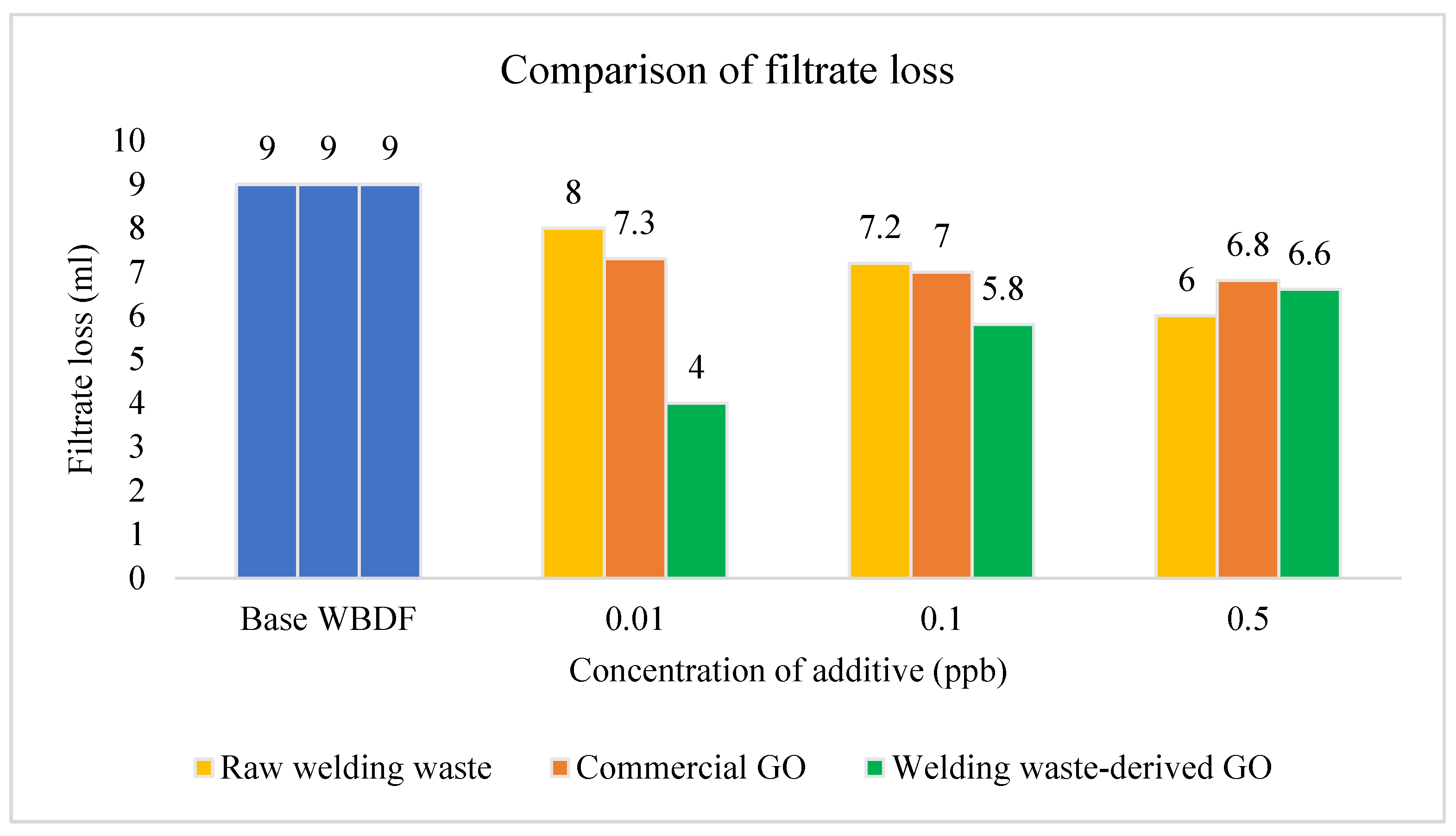

| Materials | Basic WBDF | Basic WBDF + Waste Additives | Mixing Time | Mixing Order |
|---|---|---|---|---|
| Distilled water (mL) | 300.0 | 300.0 | - | 1 |
| Bentonite (ppb) [Al2O3.4(SiO2).H2O] | 25.0 | 25.0 | 5 | 2 |
| Potassium chloride (ppb) | 20.0 | 20.0 | 2 | 3 |
| Xanthan gum (ppb) | 1.0 | 1.0 | 5 | 4 |
| Polyanionic cellulose (ppb) | 3.0 | 3.0 | 5 | 5 |
| Sodium hydroxide (ppb) | 0.1 | 0.1 | 5 | 6 |
| Barite (ppb) | 70.0 | 70.0 | 20 | 7 |
| Welding waste (ppb)/ Welding waste-derived GO (ppb)/ Commercial GO (ppb) | - | 0.01, 0.1, 0.5 | 5 | 8 |
| Concentration | Base WBDF | 0.01 g | 0.1 g | 0.5 g |
|---|---|---|---|---|
| PV (cP) | 14.0 | 16.0 | 16.5 | 17.0 |
| AV (cP) | 19.0 | 21.5 | 22.2 | 23.5 |
| YP () | 15.0 | 17.5 | 17.4 | 18.0 |
| 10sGS () | 8.0 | 8.5 | 10.0 | 11.2 |
| 10mGS () | 11.0 | 11.4 | 12.0 | 12.5 |
| FL (mL) | 9.0 | 7.4 | 7.0 | 6.8 |
| MCT (mm) | 2.82 | 1.52 | 1.44 | 1.13 |
| Concentration | Base WBDF | 0.01 g | 0.1 g | 0.5 g |
|---|---|---|---|---|
| PV (cP) | 14.0 | 25.0 | 28.2 | 30.5 |
| AV (cP) | 19.0 | 28.0 | 30.4 | 31.4 |
| YP () | 15.0 | 15.0 | 16.2 | 17.2 |
| 10sGS () | 8.0 | 7.0 | 8.0 | 8.5 |
| 10mGS () | 11 | 9 | 10 | 10 |
| FL (mL) | 9.0 | 8.0 | 7.2 | 6.0 |
| MCT (mm) | 2.82 | 2.37 | 2.25 | 1.70 |
| Concentration | Base WBDF | 0.01 | 0.1 | 0.5 |
|---|---|---|---|---|
| PV (cP) | 14.0 | 22.0 | 24.2 | 25.5 |
| AV (cP) | 19.0 | 24.0 | 26.4 | 27.0 |
| YP () | 15.0 | 17.0 | 18.2 | 19.0 |
| 10sGS () | 8.0 | 6.0 | 6.5 | 7.5 |
| 10mGS () | 11.0 | 8.0 | 9.5 | 9.7 |
| FL (mL) | 9.0 | 4.0 | 5.8 | 6.6 |
| MCT (mm) | 2.82 | 1.90 | 2.03 | 2.23 |
Publisher’s Note: MDPI stays neutral with regard to jurisdictional claims in published maps and institutional affiliations. |
© 2022 by the authors. Licensee MDPI, Basel, Switzerland. This article is an open access article distributed under the terms and conditions of the Creative Commons Attribution (CC BY) license (https://creativecommons.org/licenses/by/4.0/).
Share and Cite
Ikram, R.; Jan, B.M.; Ahmad, W.; Sidek, A.; Khan, M.; Kenanakis, G. Rheological Investigation of Welding Waste-Derived Graphene Oxide in Water-Based Drilling Fluids. Materials 2022, 15, 8266. https://doi.org/10.3390/ma15228266
Ikram R, Jan BM, Ahmad W, Sidek A, Khan M, Kenanakis G. Rheological Investigation of Welding Waste-Derived Graphene Oxide in Water-Based Drilling Fluids. Materials. 2022; 15(22):8266. https://doi.org/10.3390/ma15228266
Chicago/Turabian StyleIkram, Rabia, Badrul Mohamed Jan, Waqas Ahmad, Akhmal Sidek, Mudasar Khan, and George Kenanakis. 2022. "Rheological Investigation of Welding Waste-Derived Graphene Oxide in Water-Based Drilling Fluids" Materials 15, no. 22: 8266. https://doi.org/10.3390/ma15228266










